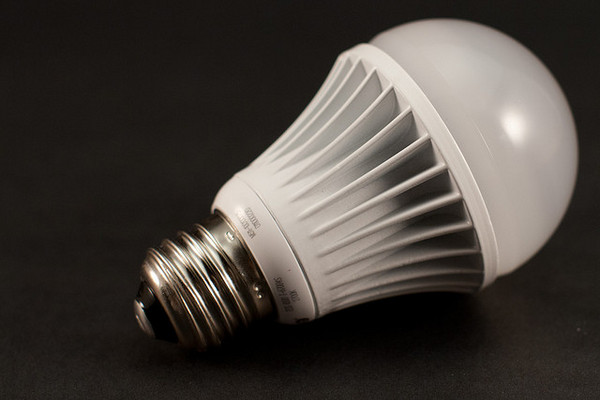The prices of Light-Emitting Diode (LED)-based lightbulbs have been dropping over the last few years, and the amount and quality of the light they put out have been rising. New dimmable LED bulbs that put out as much light as a standard 100-watt incandescent light bulb have arrived on the market this year. Their price -- in the $50 range -- is a little daunting for those of us who live paycheck to paycheck.

Then again, so was the price of compact fluorescent lightbulbs when they first hit the market 20 years ago or so. As more people bought them their price fell, and now you can get them for less than a dollar.
Which got us to thinking. The U.S. government is making massive investments in new renewable power generation. What would happen if the government made similar investments in getting LED bulbs into the hands of the people, spurring wider production, and making them easier to afford for everyone?
When the Department of Energy provides grants, loan guarantees, or tax credits to a solar or wind energy company for building new facilities, it's basically paying (your) money to add megawatts to the nation's energy generating capacity. Subsidizing energy efficient lightbulbs can do essentially the same thing, through buying megawatts to subtract from the nation's power demand. Either way the country gets its power supply below its power demand, and conservation almost always has the added benefit of avoiding environmental impact by reducing the need to generate power.
So it comes down to how much bang we can get for our buck.
Let's pick, more or less at random, one of the new entrants in the field of LED bulbs, Philips's L Prize LED. It puts out 940 lumens, equivalent to an old-school 60-watt incandescent bulb, but uses only 9.7 watts of power to do so. It costs $60 if you ignore the rebates available. That's more expensive than some 60 watt equivalent LED bulbs, including some of Philips', but let's use it as a model anyway for the sake of conservative figuring.
If you bought that LED bulb for $60 to replace a 60-watt incandescent bulb, the immediate effects -- aside from a lighter wallet -- would be that your energy demand would be lowered by 50 watts when you had the light bulb on, compared to using the older bulb you replaced. You've conserved 50 watts worth of demand, which is mathematically equivalent to buying a little 50 watt power plant with your $60. That works out to $1.20 a watt for the retail price of that relatively expensive bulb. Similar bulbs range from $2 per watt conserved to $.75 or so.
What if the Federal government bought them wholesale?
The Department of Energy (DOE)'s controversial Loan Guarantee program, widely reviled by critics of President Obama despite the fact that the program was initiated during the Bush administration in 2005, authorized the DOE to guarantee up to $34 billion in loans. A loan guarantee isn't a grant -- most of them get paid back, at least in theory. But it is an expenditure, and it carries some risk.
Most of the DOE's large loan guarantees have gone to power generation facilities. The Ivanpah Solar Electric Generating System, for instance, being built by BrightSource in the California desert, is the lucky recipient of $1.6 billion in DOE loan guarantees. When finished, that plant will have a generating capacity of 392 megawatts.
If the DOE had taken that 1.6 billion and spent it buying the above-mentioned Philips LED bulb to replace old-school 60 watt bulbs with, even if the government paid retail, it would have cut potential energy consumption by 1,333 megawatts and change, almost a gigawatt more power than the Ivanpah project would generate.
Of course, if you're buying $1.6 billion worth of a new kind of lightbulb, you're not going to pay retail. You're not only going to get a steep discount, but you're going to drive the price lower in the long term as the producer ramps up capacity to meet your demand. You're also going to save money by reducing the need for new transmission and stimulate the economy by reducing people's electric bills.
It goes without saying that it's a bit apples-and oranges to compare a loan guarantee like Ivanpah's -- where the feds stand a chance of recouping their investment -- to a grant program that buys the public lightbulbs. On the other hand, the $1.6 billion loan guarantee Ivanpah received didn't cover the entire cost of building the plant, either. Total costs for the Ivanpah plant's construction will run above $2 billion -- or nearly 1.7 gigawatts' worth of savings from LED bulbs. (If you really want to compare a loan to a lona, though, consider that it's entirely within the power of the federal government to come up with some way to recoup the money they'd spend subsidizing LED bulbs -- quantifying resulting avoided costs in generator subsidies, for instance, or perhaps even dinging public participants $10 a year on their tax returns for five years.)
Distributed generation mavens talk about rooftop solar taking off when prices for installation per watt reach parity with prices of electric power from the grid. The cost of installing rooftop solar in California depends to some degree on how much you install, but it's in the neighborhood of $6 per watt of capacity.
That's a good price, and it's getting lower. And yet it costs about one-fifth as much to save a watt with an LED bulb as it does to generate it with rooftop solar. The less power we use, the less we have to generate. And the power conserved by more efficient lighting will likely be conserved when the sun is down, meaning that LED lighting actually reduces our need for base-load power, usually provided by coal.





